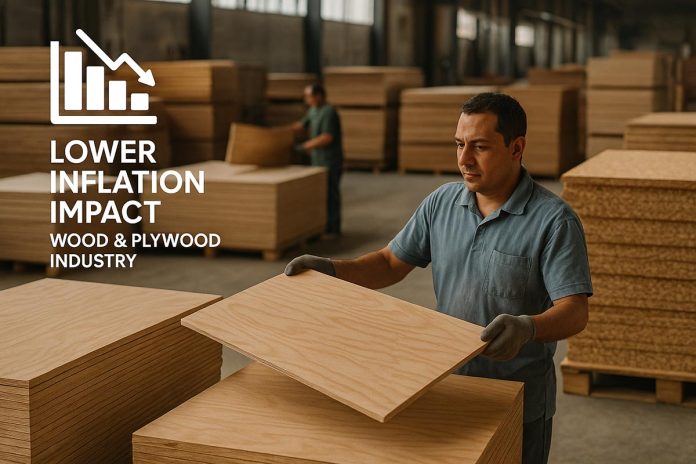The Indian wood and plywood industry is likely to experience a mixed bag of impacts following the significant easing of retail inflation in April 2025. According to the latest data released by the Ministry of Statistics and Programme Implementation, the All India Consumer Price Index (CPI) inflation fell to a provisional 3.16% in April 2025, the lowest year-on-year level since July 2019. This marks a notable decrease from the 3.34% recorded in March 2025. Food inflation, a crucial component, saw an even sharper decline to 1.78%, the lowest since October 2021.
Positive Impacts:
- Increased Consumer Spending: Lower inflation, particularly in food prices, translates to increased disposable income for consumers. This could lead to higher spending on non-essential goods, including furniture and home renovations, which are key drivers for the wood and plywood industry. As real estate activities and infrastructural developments continue to show an upward trend, the demand for interior products, where plywood is extensively used, is expected to rise.
- Reduced Input Costs (Potentially): While the primary driver of the April inflation drop was food prices, a sustained period of lower overall inflation could eventually lead to a moderation in the prices of raw materials and other inputs used in the wood and plywood industry. This includes adhesives, chemicals, and transportation costs. Lower input costs can improve the profitability margins for manufacturers. However, it is important to note that the prices of raw wood logs are also influenced by factors like government regulations on deforestation, availability of sustainable sources, and import policies.
- Stable Interest Rates: The significant fall in inflation provides a stronger case for the Reserve Bank of India (RBI) to maintain or even further reduce interest rates. Lower interest rates can make borrowing cheaper for businesses in the wood and plywood sector, facilitating investments in expansion, technology upgrades, and working capital. It can also boost demand in the housing and real estate sectors, which are major consumers of plywood.
- Enhanced Affordability for Housing and Construction: Lower inflation can contribute to stabilizing or even reducing the overall cost of construction and housing projects. This increased affordability can stimulate demand in the real estate sector, directly benefiting the wood and plywood industry, which supplies essential materials for construction, interiors, and furniture. Government initiatives aimed at affordable housing are also likely to gain momentum in a lower inflationary environment.
Potential Challenges and Nuances:
- Impact on Pricing Power: While lower input costs are beneficial, the reduced inflationary pressure might also limit the ability of wood and plywood manufacturers to raise prices. If demand does not increase significantly and competition remains intense, manufacturers might have to absorb some of the cost savings, impacting revenue growth.
- Global Economic Headwinds: Lower domestic inflation might not entirely insulate the industry from these external pressures, which could affect export demand and overall market sentiment. India’s plywood exports in 2023 were valued at USD 71.6 million, indicating a reliance on both domestic and international markets.
- Fuel and Light Inflation: It’s important to note that while overall inflation has decreased, the fuel and light inflation rate saw a significant year-on-year increase to 2.92% in April 2025 from 1.42% in March 2025. This could partially offset the benefits of lower overall inflation, as transportation and energy costs are significant for the wood and plywood industry.
- Quality Control Order (QCO) Implementation: As the industry braces for the full implementation of the BIS-QCO, which mandates ISI standards for wood panel products, the focus on quality and compliance will remain a significant factor influencing costs and competitiveness, potentially overshadowing some of the benefits of lower inflation. The QCO aims to improve the quality of domestically produced plywood and reduce reliance on imports, which accounted for 10-15% of the market.
Overall Outlook:
The lower inflation in April 2025 presents a generally positive scenario for the Indian wood and plywood industry. Increased consumer spending, potential for lower input costs, and stable interest rates can stimulate demand and improve profitability. However, the industry needs to navigate the challenges posed by global economic conditions, rising fuel costs, and the ongoing implementation of quality control measures.
The long-term growth of the Indian plywood market remains strong, with projections indicating a CAGR of around 6-8% in the coming years, driven by urbanization, rising disposable incomes, and increasing demand from the construction and furniture sectors. The easing of inflation in the short term can provide an additional boost to this growth trajectory, provided the benefits are not entirely negated by other economic factors. Manufacturers who focus on sustainable sourcing, product innovation (such as moisture-proof and fire-resistant plywood), and compliance with quality standards are likely to be better positioned to capitalize on the opportunities presented by a lower inflationary environment and the overall growth of the Indian market.


